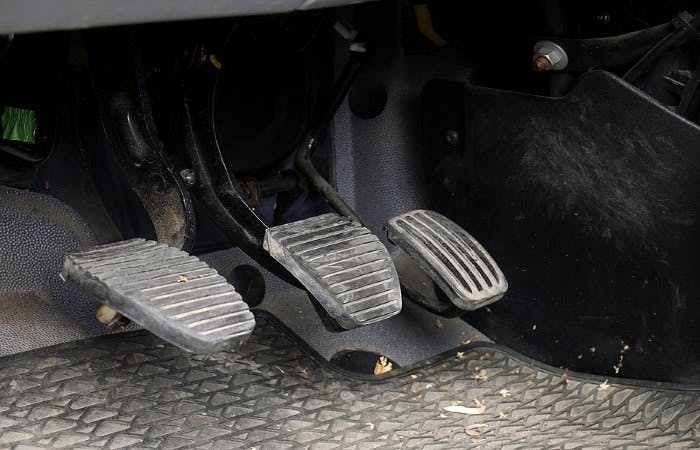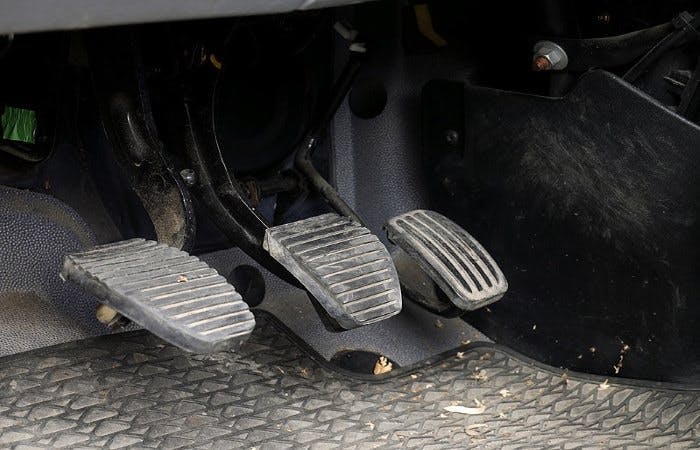
One of the first things you’ll do when you start your driving lessons is to learn how and when to change gears. It’s important to know which gear is suitable for your speed, acceleration, the conditions and features particular to the road you’re on. The right gear will allow you to control your vehicle safely, whereas the wrong one can lead to stalling, dangerous manoeuvres or excessive revving.
Many modern cars actually suggest to the driver when it’s best to change gear. But even if you’re learning in a vehicle with this feature, you’re likely to be looking at buying a cheaper, older car once you’ve passed. It’s important, therefore, not to rely on the car’s gear prompts. Instead, you need a thorough understanding of when to change up and down gear in a manual car through sound, feel and speed.
How to change gear

Let’s start with the basics. Most cars have 6 or 7 gears: 5 or 6 forward gears and a reverse gear. They are usually controlled by a stick between the driver and front passenger seats: the aptly named ‘gear stick’. To change gears, you need to press down the clutch and move the gear stick into the desired gear. Once you’ve changed gear, pull your foot slowly off the clutch while pressing the accelerator. If you’re pulling away, you’ll need to find the biting point so that you don’t stall.
The actions will probably become second nature to you over time, but to start with you may find yourself making mistakes. For instance, if your clutch is only partially depressed when you move the stick, you may hear an unpleasant sound. This is known as grinding your gears, and is bad for your car.
Tips for learning to change gear
Knowing where to place the gear stick to get each individual gear, without having to look down, can also take a bit of getting used to. Rather than holding the gear stick directly on top, one top tip is to cup the lever with your hand from one side, so that you are always pushing the lever away from your hand. This ensures you’re making a conscious and deliberate action, which can help prevent you from accidentally slipping into the wrong gear.
The more practise you have driving, the easier skills like this become, but sometimes your practical experience is limited as a learner driver. Not to worry, though: even if you haven’t got use of a car in between lessons, you can always simulate changing gear in mid-air. Once you’re confident with the movement, try adding in imaginary foot pedals: the clutch, brake and accelerator.
Gaining confidence in this way should help you transition to a real car, as changing gear effectively also relies on your ability to master clutch control. The gear stick should not move unless your clutch is pressed down, when the engine will be disengaged from the wheels.
What about gears in automatic cars?
You may have heard people say that automatic vehicles don’t have gears. This isn’t actually true. All cars have gears, because this is how the engine engages with the wheels. It’s how the car moves along. What they really mean is that automatic cars don’t have a gearstick that you have to control: the car mostly works its way through the gears by itself. However, while there is no stick in the traditional sense, you will still have to select whether you intend to move forward (usually indicated by a D for ‘drive’), backwards (‘R’ for ‘reverse’) or park (‘P’).
Semi-automatic cars are different again: they will usually have gear paddles on the indicator stalks, near the steering wheel, but, crucially, no clutch. Because of these differences, it’s easier to change gears in an automatic or semi-automatic car than in a vehicle with manual transmission—but you will still need to be aware of acceleration and rev count to drive smoothly and effectively.
How fast can you go in first gear?

Cars generally have quite a small range of speeds suitable for first gear. You will usually have to change from 1st gear to 2nd at around 10mph. Sometimes, in some cars, with enough revs, or going downhill, you can even start a car in 2nd or 3rd gear—although we wouldn’t recommend this as standard practice, and certainly not something to show off on your driving test!
Changing gears: which gear is suitable for my speed?
In terms of other gears, each vehicle is unique, meaning there is no definitive answer to the question ‘which gear should I be in at x mph?’ So, to help you establish which gear is most suitable at any given time, in different conditions, we’ve put together some pointers that you should consider.
Acceleration and gears
If you’re accelerating from a slip road onto a motorway, a lower gear with higher revs will give you more power, so you’ll be able to get up to speed quicker. If, on the other hand, you’re decelerating (slowing down), you can use a lower gear to help you brake.
Physical features of the road
Different roads will require different speeds—and not just because they’ll be subject to different speed limits. If you’re going round a corner, you will need to reduce your speed, so it’s likely you’ll need to change to a lower gear as well. This will give you much better control around bends in the road—something that might be familiar to you if you’ve driven much along country lanes.
When driving uphill, you will need to be in a lower gear than when you’re on the flat or on a decline. A low gear on a downhill, meanwhile, will also help you control your speed: another example of using your gears to brake.
Weather conditions and choosing a gear

Driving on ice is inadvisable, but sometimes there is simply no choice. If you find yourself in this position, you should choose a higher gear, where you can use fewer revs. This should help your vehicle ‘grip’ the ground as much as possible.
How do you know when to shift gear?
In addition to any automatic prompts your car gives you, there are a couple of indicators that you need to change up a gear. Your engine will start to strain when you need to go up a gear—and as your revs increase, so will the noise. You’ll be able to see how many revs you’re doing on the rev counter on your dashboard. At around 2000-2500rpm (revs per minute), you’ll probably need to change up (depending on the variables outlined above).
Equally, you should learn quite quickly how the car feels when you need to change down a gear. It will feel like you’re losing power—and if you don’t change quickly enough, you will stall the engine.
Can I skip gears?
Whether you’re shifting up or down, there are times when it's appropriate to miss out gears. However, you need to make sure that your rev count and speed is compatible with the new gear, otherwise you could be in for a bumpy, or very noisy, few seconds—and risk damaging your vehicle.
When you're stopping, it is quite common to brake, and skip from your gear straight into a much lower gear. For instance, if you are in 4th gear, and approach a traffic light that's about to turn red, there may not be time to downshift through all the gears. Neither do you have to. Instead, put your brake down, clutch down and come to a standstill, before putting the car into 1st gear. The same applies when changing up.
If you've made a turn in 2nd gear, but need to accelerate quickly to match the speed of the vehicles on the new road, you may stay in 2nd until you're ready to hit 4th gear. Skipping too many gears at once is inadvisable, though, as you will either not have enough power to warrant the action, or your huge amount of revs will offset any benefit you might have got.
What if I change into the wrong gear?

It will quickly become apparent that you’ve slipped into the wrong gear by either the noise or the feel of the engine. It’s important to correct your mistake quickly, as you could either stall, or burn your clutch out. But, as with all aspects of driving, it’s also crucial that you don’t panic. Learn which gear your car is comfortable in for different speeds. Your ability to discern this through feel alone will improve over time, although may be able to memorise the relevant gears for particular speeds and conditions fairly quickly.
What will my driving examiner be looking out for?
On your practical test, your examiner will want to see that you can select the right gear for your speed and variables in the road and conditions. They will also want you to prove your ability to change gears smoothly and avoid riding the clutch.
How do 5-gear cars differ from 6-gear cars?
There are only subtle differences between 5- and 6-gear cars. Whichever you learn in, therefore, should prepare you well for the average vehicle that you may drive after passing your test. One slight difference is that in a 6-gear car, you’re more likely to miss out gears when climbing up through them. For instance, it is quite common to go from gear 4 directly into 6th, rather than changing from 4th to 5th to 6th.
The highest gears in both types of cars are generally reserved for cruising at higher speeds—when you're on the motorway, for instance. The benefit of a 6th gear is that the vehicle can often feel more comfortable when travelling at 70mph than those limited to 5 forward gears.
Subscribe for driving advice, offers & more
We'd love to let you know about our courses, news and offers via email. You may unsubscribe at any time.
Star Genie Limited trading as PassMeFast. Company number 10093359
Copyright © 2024 owned by Star Genie Limited
PassMeFast, Blue Tower, MediaCityUK, Salford, M50 2ST
